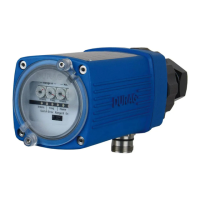3 Explosion protection
30 D−LX 200, D−LX 720
The requirements of the Compact Flame Monitor housings regarding internal
explosions are met through constructive measures. In addition, the choice of
corresponding components rules out that under normal circumstances lead to
incidents caused by sparks in or on the equipment housing.
Danger due to explosive atmosphere!
Explosions can endanger the health and safety of anyone present and cause
considerable material damage.
In explosive, or suspected explosive atmospheres:
Do not remove or change fuses when live.
Do not separate cables from the terminal strip when live.
Gas atmosphere:
In order not to inappropriately alter the gap dimensions:
Do not retro-fit the housings.
Replace the whole housing if the surface of the gap is damaged.
Only use original screws for covers.
Only use approved cable glands to secure the Ex-protection (see
Chapter 3). Ensure the correct range of cable diameter for the cable gland
for the cable used.
Only use cable that is appropriate for the Ex- space.
Dust atmosphere:
Do not retro-fit the housings. In particular do not use non-permissible
surface protection (e.g. paint) (this affects protection from electro-static
discharge).
The current protection rating (NEMA xx) must be observed.
3.7.6 D-LX…/85Ex (Class I, II, Div. 1 – Class III)
Marking:
Class I, Div. 1, Group A, B, C, D T6/T5;
Class II, Div. 1, Group E, F, G, T6/T5; Class III
Permitted ambient temperature:
-40°C (-40°F) <= Ta <= +70°C (158°F) for T6
-40°C (-40°F) <= Ta <= +85°C (185°F) for T5
3.7.7 D-LX…/86Ex (Class I, II, Div. 2 – Class III)
Markings:
Class I, Div. 2, Group A, B, C, D T6/T4;
Class II, Div. 2, Group E, F, G, T6/T4; Class III
Permitted ambient temperature:
-40°C (-40°F) <= Ta <= +40°C (104°F) for T6
-40°C (-40°F) <= Ta <= +65°C (149°F) for T4

